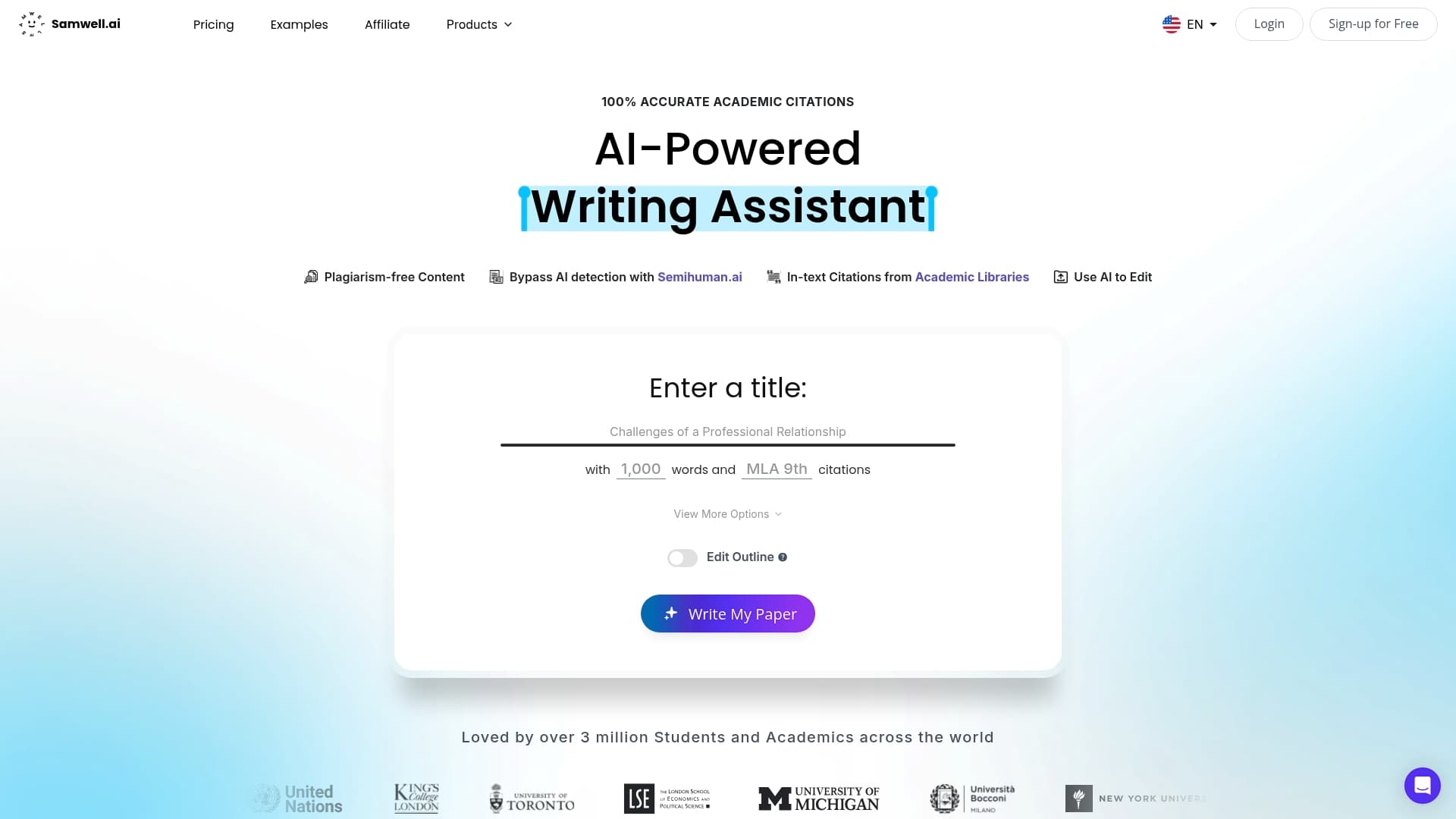Blog
Learning Materials
Personal Writing Examples: Clear Samples for Students and Educators
Updated: August 17, 2025

Personal writing shows up everywhere, from journals stashed under mattresses to essays turned in for class. Studies reveal that regular journaling can ease anxiety and even sharpen critical thinking skills. Most people assume personal writing is just freeform scribbling or confessions meant for your eyes only, but it actually opens the door to powerful self-understanding and smarter communication—and that surprises a lot of students and teachers alike.
Table of Contents
- What Is Personal Writing And Why Use It Dockerfile README.md email-templates i18n-config.ts i18nConfig.ts next-sitemap-samwell.config.js next-sitemap-semihuman.config.js next.config.js node_modules package-lock.json package.json public scripts src svgr.d.ts translations tsconfig.json Defining Personal Writing Dockerfile README.md email-templates i18n-config.ts i18nConfig.ts next-sitemap-samwell.config.js next-sitemap-semihuman.config.js next.config.js node_modules package-lock.json package.json public scripts src svgr.d.ts translations tsconfig.json The Psychological And Educational Benefits
- Types Of Personal Writing With Clear Examples Dockerfile README.md email-templates i18n-config.ts i18nConfig.ts next-sitemap-samwell.config.js next-sitemap-semihuman.config.js next.config.js node_modules package-lock.json package.json public scripts src svgr.d.ts translations tsconfig.json Narrative Personal Writing Dockerfile README.md email-templates i18n-config.ts i18nConfig.ts next-sitemap-samwell.config.js next-sitemap-semihuman.config.js next.config.js node_modules package-lock.json package.json public scripts src svgr.d.ts translations tsconfig.json Reflective And Expressive Personal Writing Dockerfile README.md email-templates i18n-config.ts i18nConfig.ts next-sitemap-samwell.config.js next-sitemap-semihuman.config.js next.config.js node_modules package-lock.json package.json public scripts src svgr.d.ts translations tsconfig.json Persuasive And Descriptive Personal Writing
- How To Create Strong Personal Writing Dockerfile README.md email-templates i18n-config.ts i18nConfig.ts next-sitemap-samwell.config.js next-sitemap-semihuman.config.js next.config.js node_modules package-lock.json package.json public scripts src svgr.d.ts translations tsconfig.json Finding Your Authentic Voice Dockerfile README.md email-templates i18n-config.ts i18nConfig.ts next-sitemap-samwell.config.js next-sitemap-semihuman.config.js next.config.js node_modules package-lock.json package.json public scripts src svgr.d.ts translations tsconfig.json Crafting Meaningful Content Dockerfile README.md email-templates i18n-config.ts i18nConfig.ts next-sitemap-samwell.config.js next-sitemap-semihuman.config.js next.config.js node_modules package-lock.json package.json public scripts src svgr.d.ts translations tsconfig.json Refining Your Writing Process
- Tips For Using Personal Writing In Education Dockerfile README.md email-templates i18n-config.ts i18nConfig.ts next-sitemap-samwell.config.js next-sitemap-semihuman.config.js next.config.js node_modules package-lock.json package.json public scripts src svgr.d.ts translations tsconfig.json Creating Safe Writing Environments Dockerfile README.md email-templates i18n-config.ts i18nConfig.ts next-sitemap-samwell.config.js next-sitemap-semihuman.config.js next.config.js node_modules package-lock.json package.json public scripts src svgr.d.ts translations tsconfig.json Designing Meaningful Personal Writing Assignments Dockerfile README.md email-templates i18n-config.ts i18nConfig.ts next-sitemap-samwell.config.js next-sitemap-semihuman.config.js next.config.js node_modules package-lock.json package.json public scripts src svgr.d.ts translations tsconfig.json Integrating Personal Writing Across Disciplines
Quick Summary
| Takeaway | Explanation |
|---|---|
| Personal writing fosters self-expression | It allows individuals to explore their thoughts and feelings authentically, enhancing emotional understanding. |
| Types of personal writing enhance depth | Various styles like narrative and reflective writing encourage different forms of personal expression, connecting emotions to experiences. |
| Creating a safe environment is essential | Educators should foster a supportive atmosphere where students can express themselves without fear of judgment. |
| Integrating personal writing boosts engagement | Cross-disciplinary personal writing connects individual experiences to academic content, making learning more relatable and impactful. |
| Refining writing through revision is crucial | Strong personal writing evolves with multiple drafts, emphasizing clear expression and emotional connection to effectively communicate insights. |
What Is Personal Writing and Why Use It
Personal writing represents a powerful form of self-expression that goes beyond traditional academic or professional communication. At its core, personal writing is an intimate exploration of individual experiences, thoughts, and emotions captured through various narrative formats.
Defining Personal Writing
Personal writing encompasses a wide range of creative and reflective writing styles that center on the writer's unique perspective. According to Landmark College, this genre includes personal narrative essays, informal responses, letters, emails, blogs, and inspirational speeches that are typically intended for a friendly audience seeking entertainment, information, or inspiration.
The essence of personal writing lies in its authenticity. Unlike formal academic writing, which demands strict objectivity, personal writing allows writers to delve deep into their individual experiences, emotions, and observations. It provides a platform for genuine self-discovery and meaningful communication.
The Psychological and Educational Benefits
Research published in the Journal of the American Board of Family Medicine highlights the significant mental health benefits of personal writing. Journaling and expressive writing can help individuals process complex emotions, reduce symptoms of depression and anxiety, and develop greater self-awareness.
In educational settings, personal writing serves multiple critical functions. The Center for the Professional Education of Teachers at Columbia University emphasizes that expressive writing enables students to reflect on their feelings and thoughts, helping them develop a unique voice and process emotional experiences during challenging times.
Students who engage in personal writing often experience several transformative benefits:
- Emotional Processing: Writing provides a safe space to explore and understand personal experiences
- Communication Skills: Regular practice improves articulation and self-expression
- Critical Thinking: Reflecting on personal experiences encourages deeper analysis and understanding
Moreover, personal writing transcends traditional educational boundaries. It can be a therapeutic tool, a method of historical documentation, and a means of connecting with others through shared human experiences. Learn more about developing your writing skills.
Whether you are a student seeking to understand yourself better, an educator guiding personal development, or simply someone interested in exploring your inner world, personal writing offers a profound pathway to self-discovery and meaningful communication.
Types of Personal Writing with Clear Examples
Personal writing encompasses diverse styles that allow individuals to express their unique experiences, perspectives, and emotions. Understanding these different types helps writers choose the most appropriate format for their intended message and audience.
Here is a comparison table summarizing the main types of personal writing mentioned in the article and their key features, along with examples. This helps readers quickly see the distinctions between different personal writing forms.
| Type of Personal Writing | Main Features | Common Examples |
|---|---|---|
| Narrative | Storytelling, chronological events, personal journey | Memoirs, personal essays, travel journals |
| Reflective/Expressive | Emotional processing, self-understanding | Journals, personal blogs, letters to oneself |
| Persuasive | Aims to influence, presents a personal viewpoint | Opinion pieces, advocacy writing |
| Descriptive | Rich, sensory details, vivid description of moments | Descriptions of cultural or meaningful experiences |
Narrative Personal Writing
Narrative personal writing focuses on storytelling and sharing individual experiences through a chronological sequence of events. According to the University of Rhode Island's Graduate Writing and Presenting Lab, narrative writing is commonly used in short stories and novels, allowing writers to create immersive accounts of personal journeys.
Examples of narrative personal writing include:
- Memoirs detailing significant life events
- Personal essays describing transformative experiences
- Travel journals documenting individual adventures
- Autobiographical reflections on personal growth
These narratives provide readers with intimate insights into the writer's world, creating emotional connections through authentic storytelling.
Reflective and Expressive Personal Writing
Research from Bay Path University highlights expository writing as a critical form of personal communication that explains concepts and experiences. Reflective and expressive personal writing goes beyond simple explanation, delving into emotional processing and self-understanding.
Key types of reflective personal writing include:
- Journals: Daily or periodic records of thoughts and feelings
- Personal blogs: Online platforms for sharing experiences
- Emotional processing essays: Deep explorations of personal challenges
- Letters to oneself: Introspective communications for personal development
These writing formats offer powerful tools for emotional healing and self-discovery. Explore more about developing effective writing techniques.
Persuasive and Descriptive Personal Writing
Personal writing can also incorporate persuasive and descriptive elements. The University of the People explains that persuasive writing aims to influence readers' perspectives, while descriptive writing paints vivid pictures of experiences.
Examples include:
- Personal opinion pieces arguing for social change
- Detailed accounts of cultural experiences
- Advocacy writing highlighting personal challenges
- Sensory-rich descriptions of meaningful moments
These forms of personal writing not only share individual experiences but also invite readers to see the world through the writer's unique lens, fostering empathy and understanding.
How to Create Strong Personal Writing
Creating strong personal writing requires a combination of self-awareness, technical skill, and genuine emotional exploration. The process involves developing a unique voice, understanding your audience, and crafting authentic narratives that resonate with readers.
Finding Your Authentic Voice
According to Edutopia, one of the most critical aspects of personal writing is developing an authentic writing voice. This means creating a writing style that genuinely reflects your individual perspective, experiences, and personality.
To develop your authentic voice, consider these strategies:
-
Practice regular writing to understand your natural communication style
-
Read widely across different genres to expose yourself to diverse writing approaches
-
Experiment with different tones and writing techniques
-
Reflect on your unique experiences and perspectives
-
Write without judgment, allowing your true thoughts to emerge
Authenticity comes from being honest and vulnerable in your writing. It means sharing your genuine thoughts, emotions, and experiences without attempting to conform to perceived expectations.
Crafting Meaningful Content
The National Center for Education Statistics emphasizes the importance of choosing writing topics that genuinely inspire and motivate you. Passionate writing emerges when you write about subjects that deeply connect with your personal experiences and interests.
Key strategies for creating meaningful personal writing include:
- Choose Compelling Topics: Select subjects that genuinely excite or challenge you
- Use Specific Details: Incorporate sensory information and precise descriptions
- Show Rather Than Tell: Use narrative techniques that help readers experience your story
- Embrace Emotional Depth: Allow yourself to explore complex feelings and experiences
Meaningful writing goes beyond surface-level descriptions. It requires deep introspection and a willingness to share vulnerable moments that reveal universal human experiences. Learn more about developing your writing skills.
Refining Your Writing Process
Strong personal writing is rarely produced in a single draft. The refinement process involves careful revision, seeking feedback, and being open to constructive criticism. This approach transforms raw personal experiences into polished, engaging narratives.
Effective revision strategies include:
- Create multiple drafts, allowing each version to become more refined
- Read your work aloud to identify awkward phrasing or unclear sections
- Ask trusted readers to provide honest, constructive feedback
- Take breaks between writing and editing to gain fresh perspective
- Focus on clarity, emotional resonance, and narrative flow
Remember that personal writing is a journey of self-discovery. Each piece you write is an opportunity to understand yourself better and connect with others through shared human experiences. The most powerful personal writing emerges when you combine genuine emotion with thoughtful craft.
Tips for Using Personal Writing in Education
Personal writing offers educators a powerful tool for enhancing student learning, emotional intelligence, and critical thinking skills. By strategically integrating personal writing approaches, teachers can create more engaging and transformative educational experiences.
Creating Safe Writing Environments
Establishing a supportive and non-judgmental writing environment is crucial for effective personal writing in educational settings. Students must feel safe expressing their thoughts, emotions, and experiences without fear of criticism or ridicule.
Key strategies for creating a safe writing environment include:
To assist educators, the following summary table presents strategies for creating safe writing environments in the classroom. This organized list allows teachers to quickly identify actionable techniques.
| Strategy for Safe Writing Environment | Description |
|---|---|
| Set clear guidelines | Establish respectful communication norms |
| Offer private or public sharing options | Let students choose whether to share writing |
| Model vulnerability | Share your own personal writing as an example |
| Provide constructive feedback | Build trust with supportive responses |
| Normalize emotional expression | Emphasize that sharing feelings is part of learning |
- Establish clear guidelines for respectful communication
- Provide options for sharing or keeping writing private
- Model vulnerability by sharing your own personal writing
- Create trust through consistent, constructive feedback
- Normalize emotional expression as a valuable learning process
By fostering psychological safety, educators encourage students to explore their inner worlds more deeply and develop stronger self-understanding.
Designing Meaningful Personal Writing Assignments
The National Writing Project emphasizes the importance of creating assignments that connect personal experiences with broader learning objectives. Effective personal writing assignments should challenge students to reflect critically while maintaining emotional authenticity.
Consider these approaches for designing impactful personal writing tasks:
- Reflective Journals: Connect personal experiences with course content
- Narrative Essays: Explore personal growth and transformative moments
- Cultural Identity Projects: Examine personal background and societal influences
- Problem-Solution Narratives: Use personal experiences to analyze complex issues
These assignments help students develop critical thinking skills while honoring their unique perspectives. Explore strategies for developing effective writing assignments.
Integrating Personal Writing Across Disciplines
Research from Stanford University's Center for Education Policy Analysis suggests that personal writing can be effectively integrated across multiple academic disciplines. By encouraging students to connect personal experiences with academic content, educators can enhance engagement and deeper understanding.
Strategies for cross-disciplinary personal writing include:
- Science: Reflecting on personal observations and research experiences
- History: Exploring family stories connected to historical events
- Mathematics: Journaling about problem-solving approaches and mathematical thinking
- Social Studies: Analyzing personal experiences through sociological perspectives
Cross-disciplinary personal writing helps students recognize the interconnectedness of their personal experiences with broader academic and intellectual contexts. This approach transforms learning from a passive to an active, deeply personal process.
By thoughtfully implementing personal writing strategies, educators can create more dynamic, empathetic, and student-centered learning environments that honor individual experiences while promoting academic growth.
Frequently Asked Questions
What is personal writing?
Personal writing is a form of expressive writing that explores an individual's thoughts, experiences, and emotions. It can take various formats, including narrative essays, reflective journals, and personal blogs.
What are the benefits of personal writing in education?
Personal writing in education enhances emotional intelligence, communication skills, and critical thinking. It allows students to reflect on their experiences and develop a unique voice, which can improve their overall academic performance.
How can I improve my personal writing skills?
Improving personal writing skills involves regular practice, seeking feedback, and embracing revision. Additionally, reading widely and experimenting with different styles can help develop your authentic voice and enhance your writing techniques.
What types of personal writing are there?
Personal writing includes several types, such as narrative writing (memoirs and personal essays), reflective writing (journals and emotional essays), persuasive writing (opinion pieces), and descriptive writing (detailed experiences). Each type allows for different forms of self-expression.
Transform Your Personal Writing Into Academic Excellence With Samwell.ai
Do you want to turn authentic personal stories and reflections into powerful academic essays? Many students and educators struggle to express personal experiences in a structured, original way that meets citation standards and avoids plagiarism risks. As the article highlights, finding your authentic voice, crafting meaningful content, and refining personal writing are top priorities — but these can be overwhelming without the right support.

With Samwell.ai, you have an advanced partner designed specifically for students and academics like you. Whether you need help transforming emotional narratives into well-organized essays or want to ensure your reflective writing meets MLA or APA requirements, Samwell.ai’s suite of AI-driven tools makes the process faster and more reliable. Start with customized essay generation, ensure every paragraph is original, and take control with features like the Power Editor and Guided Essays. Join over one million learners who are already writing with greater confidence. Visit Samwell.ai now and experience the difference between simple journaling and academic achievement.
Generate essays with Samwell.ai
Whether you’re a publisher, professor, journalist, or student, let us tailor a plan just for you.Most Read Articles

Your Guide to Help Writing a Essay Successfully
Expert tips for help writing a essay - from crafting a thesis to structuring your essay effectively.

How to Write Critical Thinking Essay: Expert Tips
Expert tips for writing a critical thinking essay. Learn how to structure, choose topics, and use evidence effectively.'

How to Write a Good Hook: A Step-by-Step Guide
Master the art of crafting a good hook with our guide. Create compelling openers for a memorable first impression.
